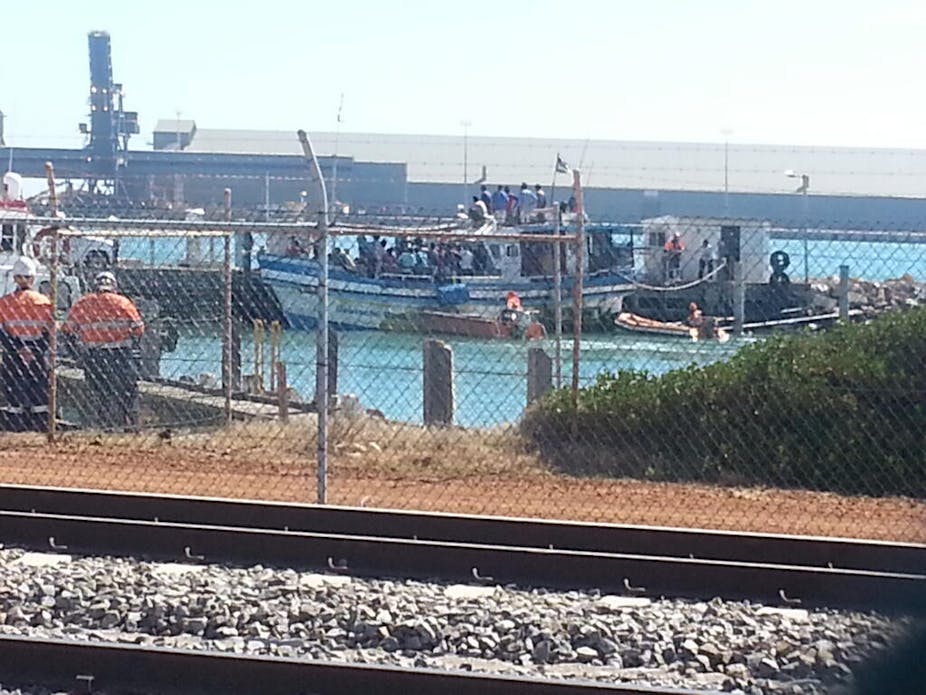After relying on immigration policies taken from the copy book of John Howard, the Liberal party has turned to defence technology for its latest policy innovation involving drones detecting boats carrying asylum-seekers in Australian waters.
One wonders just how far the Leader of the federal opposition, Tony Abbott, will go to capitalise on perceived fears about “boat people”. Such fears have long existed in the Australian psyche from hysteria about an invasion by the “Yellow Peril” to Australia’s north and panic at the end of the White Australia policy. Concerns about border security have reached new heights with the arrival of a boat in Geraldton, West Australia.
To his mantra of “turn back the boats” Abbott has now added calls to have naval commanders intercept boats and make asylum determinations at sea. He already supports a Labor plan to excise the mainland from Australia’s migration zone (which is another Howard-era policy proposal), suggests that police and neighbours should be notified of asylum-seekers living in communities and, if re-elected, has long stated he would re-introduce Temporary Protection Visas. With such a raft of policy proposals on the table one wonders when the limits of political posturing on immigration will be reached, if at all.
Absent from current debates about asylum-seekers and border security, which reached fever pitch last year during the height of boat arrivals and asylum-seeker deaths, is an acknowledgement that many other industrialised countries are facing similar issues. Take asylum-seeker arrivals. The United Nations High Commissioner for Refugees (UNHCR) reported an 8% increase in asylum applications in 44 industrialised countries between 2011 and 2012. Last year Australia experienced a 37% increase in asylum-seeker arrivals, but the UN refugee agency made it very clear that “by comparison, asylum levels in Australia continue to remain below those recorded by many other industrialised and non-industrialised countries”.

Asylum-seeker numbers are increasing worldwide due to a sharp increase in conflict in countries such as Syria where the death toll is approaching 70,000. More people are fleeing Afghanistan, a country ranked 175 on the Human Development Index, due to fears over the future of the country after foreign troops withdraw in 2014. These two countries are the top two source countries for asylum-seekers world-wide. In 2011-12, most asylum-seekers arriving by boat to Australia originated from Afghanistan. The recent group of boat arrivals in Geraldton began their journey in Sri Lanka. In its 2013 World Report, Human Rights Watch noted there has been no inquiry into war crimes in Sri Lanka during 2008-9 when 40,000 civilians were killed. Human Rights Watch has also raised concerns about the torture of Tamil separatists.
People fleeing violence and persecution in Syria, Sri Lanka and Afghanistan, are quite obviously leaving because of insecurity in their countries. Rhetoric from politicians about deterrents and “stopping the boats” is targeted at the Australian voting public and not prospective asylum-seekers. We know that in the asylum policy, deterrents simply do not work. We also know that deterrent messages rarely reach asylum-seekers. And with most asylum-seekers originating from repressive regimes, even if they did receive these messages they would likely ignore them. Faced with the potential of torture, persecution or death in their own country and finding no safety in neighbouring countries, displaced people are on the move and seeking asylum in industrialised countries including Australia. The sooner we come to terms with the nature of global asylum flows and patterns, the sooner we will be able to put in place responses that respect national sovereignty and people’s rights to seek asylum.
The Houston Panel report acknowledged many of these global realities but still clung to outdated notions that asylum-seekers can be “pushed” and “pulled” through Australian policy settings. It did well to recommend an urgent need for regional approaches to migration policy and commitment to improving processes so that people can find protection in their own countries and neighbouring or transit countries.
Suggestions by Opposition Immigration Spokesperson Scott Morrison that the West Australian coastline is “open game” for asylum-seekers might serve to convince Australian voters about his immigration credentials against a new Immigration Minister, but will do nothing to stop boats arriving and people claiming asylum in Australia. Take a deep breath as we’re in for a long haul of political posturing with very few plausible solutions.

